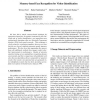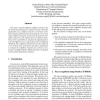113
Voted
FGR
2000
IEEE
15 years 4 months ago
2000
IEEE
We show that a simple, memory-based technique for appearance-based face recognition, motivated by the realworld task of visitor identification, can outperform more sophisticated a...
112
Voted
FGR
2000
IEEE
15 years 4 months ago
2000
IEEE
This paper presents a novel approach to robust and flexible person tracking using an algorithm that combines two powerful stochastic modeling techniques: The first one is the tech...
115
Voted
FGR
2000
IEEE
15 years 4 months ago
2000
IEEE
This paper compares different confidence measures for the results of statistical face recognition systems. The main applications of a confidence measure are rejection of unknown p...
127
Voted
FGR
2000
IEEE
15 years 5 months ago
2000
IEEE
In this paper, we consider the problem of robust localization of faces and some of their facial features. The task arises e.g. in the medical field of visual analysis of facial p...
150
Voted
FGR
2000
IEEE
15 years 5 months ago
2000
IEEE
Colorhasbeen widelyused for handsegmentation. However, many approaches rely on predefined skin color models. It is very difficult to predefine a color model in a mobile applica...
125
Voted
FGR
2000
IEEE
15 years 5 months ago
2000
IEEE
This paper describes a novel system for 3D head tracking under partial occlusion from 2D monocular image sequences. In this system, The Extended Superquadric (ESQ) is used to gene...
115
Voted
FGR
2000
IEEE
15 years 5 months ago
2000
IEEE
We present two methods using mixtures of linear subspaces for face detection in gray level images. One method uses a mixture of factor analyzers to concurrently perform clustering...
126
Voted
FGR
2000
IEEE
15 years 5 months ago
2000
IEEE
We present a method for tracking the 3D position of a nger, using a single camera placed several meters away from the user. After skin detection, we use motion to identify the ges...
122
Voted
FGR
2000
IEEE
15 years 5 months ago
2000
IEEE
Human motion can be understood on many levels. The most basic level is the notion that humans are collections of things that have predictable visual appearance. Next is the notion...
120
Voted
FGR
2000
IEEE
15 years 5 months ago
2000
IEEE
We present a method to learn models of human heads for the purpose of detection from different viewing angles. We focus on a model where objects are represented as constellations ...


